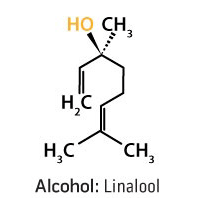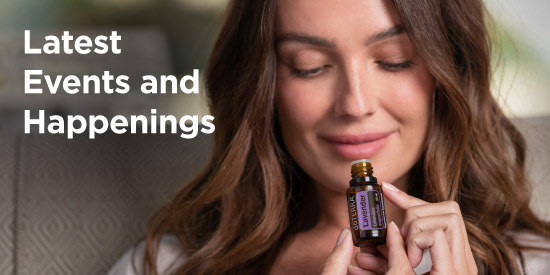Origin: a Latin derivative
meaning "Gift of the Earth."
Part 5: Oxygenated Compounds—Alcohols
The next layer of complexity in essential oil chemistry is the addition of functional groups to terpene backbones. Addition of non-carbon atoms alters the properties of a terpene by changing its reactivity. Oxygenated groups are the most common type of functional group found in essential oils. As with terpenes, it is important to understand the different classes of oxygenated compounds that exist, as each class contributes its own unique potential health benefits.
Oxygenated essential oil constituents always have a terpene backbone, so the terpene name is still used in classifying the molecule. For instance, if an alcohol group (one oxygen and one hydrogen) was added to a monoterpene, the molecule would be called a monoterpene alcohol. If a ketone group (one oxygen) was added to a sesquiterpene, the molecule would be classified as a sesquiterpene ketone. In many cases however, the molecule is given a unique single name and the “monoterpene” or “ketone” words are omitted.

Among the most widely studied and valuable functional groups found in essential oils are alcohols, which are groups composed of an oxygen and a hydrogen atom (usually written as “-OH”). Sometimes, this group is alternatively referred to as a hydroxyl group. A good way to identify these molecules is by looking at their scientific name, which often ends with the suffix “-ol.” Alcohols typically have pleasant aromas that are well tolerated. Common alcohols found in essential oils include: menthol, linalool, and santalol.
Main Health Effects:
- Powerfully cleansing, protects against environmental threats1
- Uplifting effects on mood2
- Supports restful sleep3
- Supports a healthy cardiovascular system4*
| Essential Oil | Main Alcohol Constituent(s) | Amount |
| Sandalwood2,3 | santalol | Approximately 90% |
| Basil2 | linalool | Approximately 80% |
| Rose2 | citronellol, geraniol, nerol | Approximately 60% |
| Marjoram 2,4* | linalool, terpinenol | Approximately 55% |
| Geranium2 | citronellol, geraniol | Approximately 50% |
| Melaleuca1 | terpineol | Approximately 50% |
| Peppermint2 | menthol | Approximately 50% |
| Cilantro1 | linalool, decenol | Approximately 45% |
| Jasmine2 | phytol, linalool | Approximately 45% |
| Lavender2,3 | linalool | Approximately 35% |
| Coriander2 | linalool, geraniol | Approximately 30% |
| Clary Sage2,3 | linalool | Approximately 25% |
| Patchouli2 | patchoulol | Approximately 25% |
| Cedarwood2 | cedrol | Approximately 20% |





